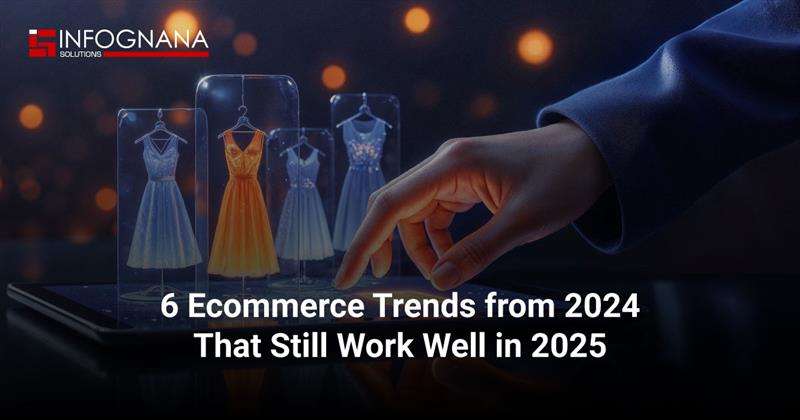6 Ecommerce Trends from 2024 That Still Work Well in 2025
Ecommerce is known for its ever-evolving landscape. It has seen trends that come and go, but not every trend comes with an expiration date. Some would rather mature, evolve, and continue driving results for years. That’s exactly what we’re seeing in 2025. Many of the biggest trends from 2024 are not only still relevant today but have become even more powerful due to advancements in technology, shifting consumer behavior, and broader industry adoption.
If you’re an ecommerce brand looking to stay relevant in 2025 and beyond, you don’t need to chase every new shiny thing that comes by. Sometimes, doubling down on what already works and doing it better is the most strategic move you can make.
Let’s take a closer look at 6 ecommerce trends from 2024 that are still working well in 2025.
1. AR is Turning Online Stores into Virtual Showrooms
One of the longest-standing barriers to online shopping has always been the lack of tactile interaction, as shoppers can’t touch, try, or truly visualize a product. But augmented reality (AR) continues to change that, offering a next-level virtual experience that mimics in-store browsing.
By 2025, AR is no longer just a novelty; it’s a shopper expectation. Retailers are using AR to allow customers to see furniture in their living rooms, try on glasses virtually, or walk through immersive product demos — all from their phones or desktops. This tech isn’t fading; it’s rather becoming a standard feature of the modern ecommerce toolkit.
2. Personalization Gets Smarter and More Ethical
In 2024, personalization meant curated product recommendations, customized ads, and one-to-one marketing. In 2025, it’s all that, but with smarter data handling and a focus on customer trust.
Today’s ecommerce personalization strategies blend AI and customer data to build highly tailored shopping experiences across email, SMS, ads, and on-site journeys. But equally important is the emphasis on “consent”. Consumers are more privacy-conscious, and brands that give users control over their data while still delivering relevant experiences are the ones that earn lasting loyalty. Transparency isn’t just good ethics, it’s good business.
3. AI Chat Feels More Human
Gone are the days of frustrating, clunky chatbots that couldn’t understand a basic question. Thanks to generative AI, chat marketing in 2025 feels easy, intelligent, and helpful without giving the customers the feel of being robotic.
Modern ecommerce brands are using AI-powered chat tools not just for customer service, but to assist with product finds, deliver tailored offers, and even guide shoppers through checkout. These virtual assistants are becoming key players in marketing automation, suggesting relevant products in real-time, and are capable of nurturing customers and building meaningful relationships with them, all without human intervention.
4. Social Media is a Shopping Destination
Scrolling has become shopping, and this trend has intensified in 2025. Instagram, TikTok, and Facebook have doubled down on their ecommerce capabilities, and consumers are responding in a big way.
Live shopping, one-click checkouts, and in-app storefronts make social platforms a seamless path from inspiration to purchase. What used to be a marketing channel is now a full-fledged ecommerce environment. Small brands are making the best use of social platforms to reach new audiences without the overhead of traditional marketing through online retail platforms, while larger brands are using it to inject personality and interactivity into their shopping experience. Customers find it very useful as they can directly interact with the brand in a personal chat to get price quotes, offers, updates, and more.
5. Influencers Are Still Driving Sales
Influencer marketing isn’t going anywhere, but how it’s being used has evolved. In 2025, authenticity matters most.
Younger shoppers, especially Gen Z, are steering away from overly polished ads and instead moving toward influencers who integrate products naturally into their lives. Brands are seeing success by mixing traditional influencer partnerships with user-generated content, micro-influencers, and real customer reviews to build trust.
Ecommerce platforms are even embedding video reviews and influencer content directly onto product pages, merging entertainment with validation to drive conversion. Most products also offer discounts to customers who use a certain influencer’s promo code after watching their video.
6. Sustainability Is a Decision-Making Factor
Eco-conscious shopping isn’t just a fad; it’s the new norm. Shoppers, especially Millennials and Gen Z, are actively seeking out brands that align with their values.
In 2025, brands that can show real, measurable sustainability efforts, from ethical sourcing to eco-friendly packaging, are standing out. Transparent reporting, certifications, and carbon-neutral options are helping customers make informed choices, and they’re willing to pay more for it. This makes sustainability not only the right thing to do but a smart business strategy.
Ready to Put These Trends into Action?
At Infognana Solutions, we don’t just follow ecommerce trends — we help businesses implement them in a customized fashion that works to their advantage. Whether you’re looking to support AR capabilities, smarter personalization, or integrate advanced chatbots, our ecommerce solutions make it easy for your business to stay competitive in 2025 and beyond. Get in touch with us now!



